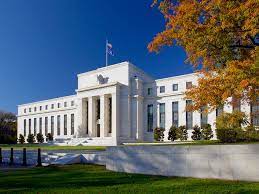Investment Strategies
US Federal Reserve Raises Rates – Wealth Managers' Reactions

The US central bank said it will raise its federal-funds rate to a target range between 0.75 per cent and 1 per cent.
The US Federal Reserve has raised rates by half a percentage point, or 50 basis points – the largest single rise in more than two decades – to try to curb inflation running at levels not seen since the early 1980s. The move, while not totally unexpected given previous indications from the central bank, nevertheless brings home the reality of higher rates for investors. Wealth management asset allocators know that the era of ultra-low rates, which has encouraged a shift to less liquid assets such as private equity and credit over the past decade, is beginning to change. A decade and more of money printing (aka quantitative easing), added to the energy price spike amidst “Net Zero” policies, Russia’s invasion of Ukraine and supply-chain disruptions wrought by the pandemic, have added to the pain. Some economists might argue that the rising energy cost factor is, in a way, a tax on growth and hence deflationary. Even so, the data appears to suggest that inflation isn’t proving a short-lived phenomenon. So the Fed, under chairman Jerome Powell, has to act.
Here are views from a number of wealth management firms, economists and others.
Gurpreet Gill, macro strategist, global fixed income,
Goldman Sachs Asset Management
With market pricing already pointing to a high probability of a
0.75 per cent rate hike in June, there was limited room for a
hawkish surprise at today’s meeting. Today’s 0.5 per cent rate
hike by the Federal Open Markets Committee was therefore widely
expected. We think the Fed will frontload its hiking cycle,
ultimately moving the policy rate to a neutral setting of between
2 per cent and 3 per cent this year.
Growth looks resilient, despite GDP in the first quarter falling short of expectations. In this context, the Fed is unlikely to deviate from its path of ‘expeditiously’ aggressive tightening until it reaches a neutral policy setting. Thereafter, we expect the Fed’s policy decisions to turn more data dependent.
Seema Shah, chief strategist, Principal Global
Investors
The FOMC today made their first meaningful move
toward righting their inflation wrong, and this should be
welcomed by investors rather than feared.
Even so, this first 0.5 per cent move since 2000 is not nearly enough. In the seven weeks since Fed lift-off, the inflation risk seems to have only grown. Headline inflation is near 9 per cent, inflation expectations remain elevated, there are almost two vacancies to each unemployed person, and measures of wage growth continue to rise.
Inflation may well peak in the coming months, but the broadening and intensification of price pressures imply that inflation will decline very gradually. We expect it to settle at around 5 per cent by year-end – more than double the Fed’s target. So, the Fed will need to look beyond simmering growth risks, and instead remain sharply focused on its inflation fight. The first back-to-back hikes of over 0.25 per cent since 1984 are beckoning.
Richard Flynn, UK managing director, Charles
Schwab
Investors will be unsurprised by today's announcement. Markets
had been bracing for the Fed to raise interest rates by a
half-point, a much sharper move than the quarter-point hike two
months ago. Since March, the Fed's plans have evolved in the face
of historically high levels of inflation. Financial conditions
have begun to tighten as the Fed raises short-term interest rates
and emphasizes its commitment to reining in price rises.
Alongside tightening monetary policy, a number of risks –
persistently high inflation, indications that consumer demand is
softening, and the economic consequences of the Russian invasion
of Ukraine – have raised investors' concerns about the strength
of future economic growth. In this context, market volatility is
likely to continue.
Ronald Temple, co-head of multi-asset and head of US
Equity, Lazard Asset Management
We didn’t get shock and awe, but we did get meaningful tightening
and a clear signal that more 50bps hikes are ahead. While a
sharper tightening could easily be justified against a backdrop
of full employment and undesirably high inflation, the Fed
appears to have prioritized growth over inflation, easing
the economy into, ideally, a soft landing. The key data to watch
going forward will be shelter costs, job growth, and wage
increases, to ascertain whether even stronger actions are
warranted.
Chief Investment Office, UBS Global Wealth
Management
Given our base case of moderating growth and inflation, we think
equity markets will finish the year higher than current levels.
We continue to favor areas of the market that should outperform
in an environment of high inflation, rising rates, and elevated
volatility.
With inflation high and interest rates rising, we think the economic and market environment is favorable for value investing. We recommend investors, who have been under allocated to value after a long period of underperformance, to add to long-term positions in value stocks or value-oriented sectors and markets including global energy and the UK.
In fixed income, areas of value have emerged following the rise in yields in recent weeks. We see an opportunity in environmental, social, and governance (ESG) engagement high yield bonds. We retain a preference for areas of private credit, such as first lien loans to middle-market companies.
Adding some portfolio hedges can reduce volatility and risk. Broad commodities have performed well historically during inflation regimes, and we think they represent an effective geopolitical hedge given the risk of further supply disruptions. We see room for another 10 per cent move up in total return for broad commodity indexes over the next six months and prefer active commodity exposure.